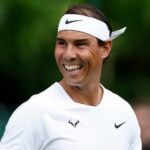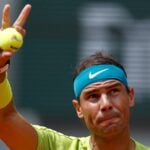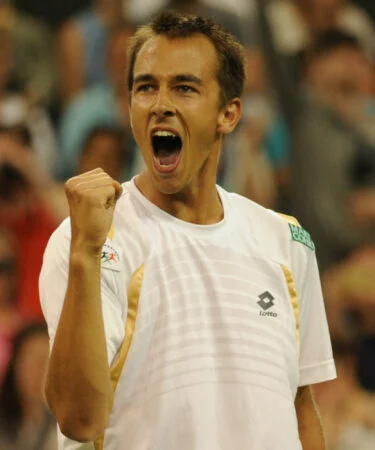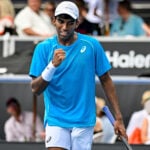June 28, 2012: The day Rosol stunned Nadal at Wimbledon
Each day, Tennis Majors takes you back in time to an important moment in tennis history. On this day, June 28, in 2012, Lukas Rosol upset Rafael Nadal at Wimbledon
 Rafael Nadal of Spain waves farewell to the Centre Court after his defeat to Lukas Rosol, right
Rafael Nadal of Spain waves farewell to the Centre Court after his defeat to Lukas Rosol, right
What happened exactly on that day and why it is memorable in tennis history?
On this day, June 28, 2012, in the second round of Wimbledon, Rafael Nadal suffered a shocking loss to unheralded world No 100 Lukas Rosol (6-7, 6-4, 6-4, 2-6, 6-4). The Czech played a close-to-perfect match to eliminate the Spaniard, who had reached the final in his five last appearances at the All England Club (claiming the title twice) and who had played the final of the last four Grand Slam tournaments. For Nadal, it was the beginning of a series of disappointments at Wimbledon — where the 2008 and 2010 champion would not go past the fourth round again until 2018.
The players involved: Rafael Nadal and Lukas Rosol
- Rafael Nadal, already a legend
In June 2012, Rafael Nadal was only 26, but his achievements had already secured him a chapter in tennis history books. His clay-court records were outstanding. Almost unbeatable on his favourite surface, he had won the French Open at his first attempt in 2005 (defeating Mariano Puerta in the final, 6-7, 6-3, 6-1, 7-5). After that he had triumphed at Roland-Garros five times — in 2006, 2007, 2008, 2010, and 2011, holding a 45-1 record in Paris. Apart from Robin Soderling, who beat him in the 2009 fourth round (6-2, 6-7, 6-4, 7-6), no one had managed to win more than one set against Nadal at Roland-Garros. He held a record of 81 consecutive matches won on red dirt, on which he had already won 32 tournaments. Besides, after his second Grand Slam triumph, he improved his game, making it more aggressive, to make it more effective on fast surfaces. Defeated by Roger Federer in the Wimbledon final in 2006 and 2007, he eventually claimed the title at the All-England Club in 2008, edging his Swiss rival in one of the greatest matches in tennis history (6-4, 6-4, 6-7, 6-7, 9-7). He then became world No 1 for the first time, interrupting Federer’s 237-week reign.
In 2009 he claimed a first Grand Slam title on hard courts at the Australian Open, where he survived a five-hour semi-final against Fernando Verdasco (6-7, 6-4, 7-6, 6-7, 6-4), before battling for five sets to beat Federer in the final (7-5, 3-6, 7-6, 3-6, 6-2). Injuries troubled him in the following 12 months, but he came back stronger than ever at the spring of 2010 by taking his revenge against Soderling in the Roland-Garros final (6-4, 6-2, 6-4) before claiming a second Wimbledon title — beating Tomas Berdych in straight sets in the final (6-3, 7-5, 6-4). In September of 2010, Nadal achieved the career Grand Slam by defeating Novak Djokovic in the US Open final (6-4, 5-7, 6-4, 6-2). At that time, it seemed like Nadal was going to dominate the game, but in 2011 the Serb increased his level and became the new leader on the tour. Defeated by Djokovic in the finals of Indian Wells, Miami, Madrid, Rome, Wimbledon, and the US Open, the Spaniard saved his season by winning Roland-Garros for the sixth time — defeating Federer in the final once again (7-5, 7-6, 5-7, 6-1). In the final of the 2012 Australian Open, Nadal was edged out once again by Djokovic (5-7, 6-4, 6-2, 6-7, 7-5) and it really looked like the Serb had taken the advantage in the rivalry. However, Nadal once again prevailed at Roland-Garros to claim his seventh title in Paris, and he was one of the favourites at Wimbledon.
- Lukas Rosol, on the edge of the top 100
Born in 1985, Lukas Rosol didn’t break into the top 100 before 2011. That year, he obtained the best result of his career by making his way out of the Roland-Garros qualifications before reaching the third round, scoring a great win against world No 8, Jurgen Melzer (6-7, 6-4, 4-6, 7-6, 6-4). He climbed as high as world No 65, but in June 2012 he was world No 100.
The place: Wimbledon, south-west London
Wimbledon is the oldest and the most prestigious tennis tournament in the world. Held at the All-England Lawn Tennis & Croquet Club since 1877, it moved to its current location in 1922. — the same year when the Centre Court was built. Considered by many as the most intimidating court in the world, with its famous Rudyard Kipling quote above the entrance (“If you can meet with triumph and disaster and treat those two impostors just the same”), the Centre Court had seen the best players of all time competing for the title. After the US Open switched to clay and then hard court in the 1970s, and after the Australian Open switched to hard court in 1988, Wimbledon remained the only Grand Slam tournament to be played on grass — a surface that is usually more suitable for serve-and-volley players. Not only did Wimbledon keep its surface, but it also maintained old-fashioned traditions such as the white dress code and the fact that the defending champion was always the first to play on the Centre Court.
The facts
In 2012, despite his game style which many deemed not fit for grass-court tennis, Rafael Nadal was on the favourites when Wimbledon started. Since 2005 and a second-round loss to Gilles Muller, the King of Clay had also been one of the best players on grass, reaching the final at the All England Club in 2006 and 2007 (lost to Federer), triumphing in 2008 and 2010, before finishing runner-up to Novak Djokovic in 2011. The Bull of Manacor had participated in the last four Grand Slam finals, and after a great clay-court season, he was a serious contender for world No 1.
In the first round, Nadal easily defeated another lefty, Thomaz Belluci, from Brazil (7-6, 6-2, 6-3), and when he entered the Center Court to face world No 100, Lukas Rosol, in the second round, no one thought the Czech could be any threat for last year’s runner-up. However, Rosol boldly took his chances, displaying a high-risk game to deprive Nadal of the long rallies that the Spaniard needed to find his pace. The Czech obtained a set point at 6-5, but when Nadal saved it with an ace and took the set (7-6), most of the spectators probably thought that Rosol was going to collapse after having been on fire.

Rosol didn’t collapse. On the contrary, he broke Nadal’s serve early in the second set and kept controlling the rallies by permanently taking the initiative. He knew that if he wanted to beat Nadal, he had to cut the rallies short and to play as aggressively as he could. Suddenly, it looked like a major upset could actually happen — a possibility that was confirmed when Rosol won the second and third set (6-4, 6-4).
Nadal kept fighting, and in the fourth set, he seemed to have found his pace. The Spaniard regained control of the match, taking the set 6-2 to push Rosol into a dangerous decider. However, Nadal’s momentum was broken by the organisers’ decision to close the roof — which stopped the match for 40 minutes. When play resumed, Rosol was unstoppable. He broke Nadal early and, winning 95 percent of the points on his first serve, he held his serve until the end. The Czech won the last game to love with three aces and a forehand winner.
“I was just like somewhere else,” Rosol said about the fifth set, according to The New York Times. “I mean maybe it’s once in life you can play like this against Rafael Nadal on Centre Court, and you can win against him.”
Nadal, although obviously shattered by his opponent’s performance and not very happy about the decision to close the roof, tried to hide his disappointment in the press conference.
“Is not a tragedy; it’s only a tennis match,” he said. “When an opponent plays like he wanted to play in the fifth, you are in his hands.
What next?
Lukas Rosol would be defeated by Philip Kohlschreiber in the following round (6-2, 6-3, 7-6). The performance against Nadal would remain the highlight of his career in singles. The Czech would still claim two titles (in Bucharest in 2013, and in Winston-Salem in 2014), which would allow him to climb as high as world No 26 in 2014.
Rafael Nadal would not play another match in 2012. Suffering from a knee injury, he would withdraw from the Olympic Games, the US Open, and even the 2013 Australian Open. He would come back on the tour in February 2013, on clay, in Vina del Mar. His loss against Rosol was the first of a series of disappointments at Wimbledon. He was defeated in the first round by Steve Darcis in 2013, then in the fourth round by Nick Kyrgios in 2014, and he would suffer another great upset in the 2015 second round against Dustin Brown. Defeated in the fourth round by Gilles Muller in 2017, he would make his way back into the semi-finals in 2018 (lost to Djokovic 6-4, 3-6, 7-6, 3-6, 10-8) and in 2019 (defeated by Federer 7-6, 1-6, 6-3, 6-4).















